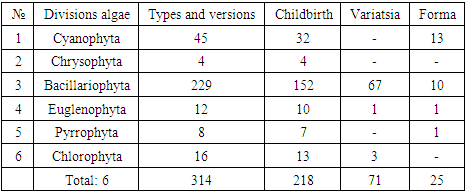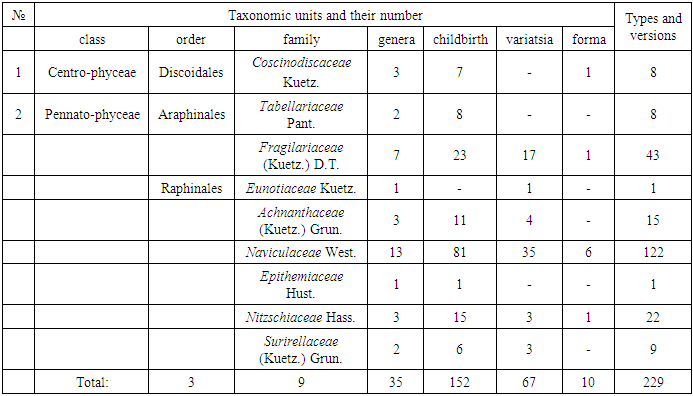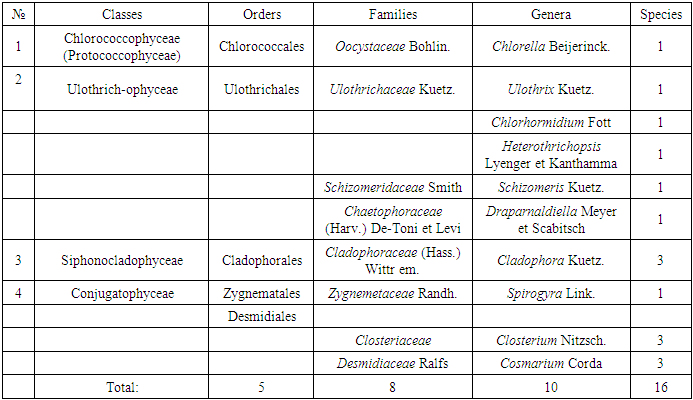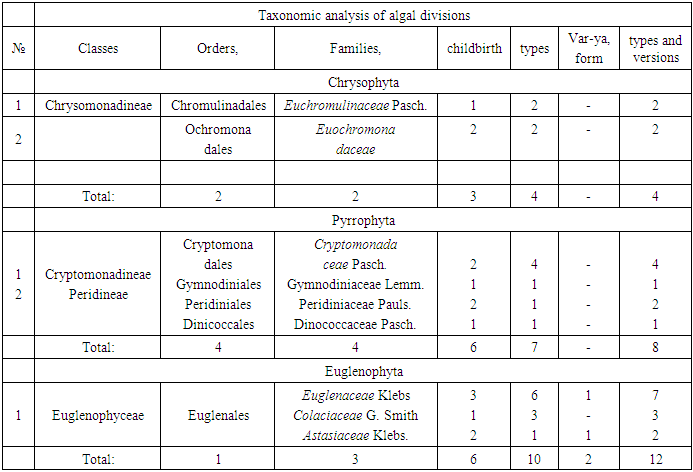Muattarkhan Yuldashova, Maqsadoy Djorabaeva, Adolatkhan Solieva, Asilbek Tolqinov, Davronbek Saminjanov, Dilfuzakhan Rakhimova, Isroiljon Usmonov
Researcher, Fergana State University, Uzbekistan
Copyright © 2022 The Author(s). Published by Scientific & Academic Publishing.
This work is licensed under the Creative Commons Attribution International License (CC BY).
http://creativecommons.org/licenses/by/4.0/

Abstract
The results of the taxonomic and comparative analysis of the algal flora of the channels of the Ferghana Valley (Big Fergana main canal, North Fergana main canal, South Fergana main canal) revealed that the algoflora of the channels has a more complex structure. When studying the general condition of algae, 6 divisions, 13 classes, 19 orders, 34 families, 314 species and varieties of species belonging to 72 genera (218 species, 71 variations, 25 forms) were identified. Of these, Cyanophyta - 45, Chrysophyta - 4, Bacillariophyta - 229, Pyrrophyta - 8, Euglenophyta - 12, Chlorophyta - 16 species and varieties.
Keywords:
Identification of algoflora, Environment, Flows, Round and round shapes, Water tanks, Environment, Natural environment and algae
Cite this paper: Muattarkhan Yuldashova, Maqsadoy Djorabaeva, Adolatkhan Solieva, Asilbek Tolqinov, Davronbek Saminjanov, Dilfuzakhan Rakhimova, Isroiljon Usmonov, Taxonomical and Comparative Analysis of the Algoflora of the Canals of the Fergana Valley, International Journal of Virology and Molecular Biology, Vol. 11 No. 3, 2022, pp. 29-32. doi: 10.5923/j.ijvmb.20221103.01.
1. Introduction
The results of the taxonomic and comparative analysis of the algoflora of the channels of the Ferghana Valley (BFMC, NFMC, SFMC) revealed that the algoflora of the channels has a more complex structure. When studying the general condition of algae, 6 divisions, 13 classes, 19 orders, 34 families, 314 species and varieties of species belonging to 72 genera (218 species, 71 variations, 25 forms) were identified. Of these, Cyanophyta - 45, Chrysophyta - 4, Bacillariophyta - 229, Pyrrophyta - 8, Euglenophyta - 12, Chlorophyta - 16 species and varieties. Table 1. Taxonomic analysis of canal algoflora Ferghana valley (2021-2022)
 |
| |
|
According to the taxonomic structure of the algae of the channels of the Fergana Valley, the algae Bacillariophyta - 229 are leading among the divisions of algae and account for 79.76% of the total number and species (152 species, 67 variations, 10 forms).In the following places, Cyanophyta - 45 (32 species, 14.33%); Chlorophyta - 16 tons (5.10%); Pyrrophytes - 8 (2.55%), Euglenoids - 12 (3.82%). The number of species and varieties of Chrysophyta algae (4; 1.27%) is a minority.When analyzing the taxonomic structure of the algae sections of the channels of the Ferghana Valley, it was found that the algae of the Basillariophyta section belong to 2 classes, 3 orders, 9 families, 229 species and genera of 35 genera.221 species and subspecies from the class Pennatophyceae, 96.51%, and 8 species and species from the class Centrophyceae, 3.50%, were identified. Fragilariaceae (Kuetz.) Belongs to the class Pennatophyceae D.T. (43), (Table 2).Table 2. Taxonomic analysis of algae of the division Bacillariophyta
 |
| |
|
Naviculous western. (122), Nitzschiaceae Hass. (22 ta), Achnanthaceae (Kutz.) Grun. (15), families differ in species richness and number of species.Tabellariaceae Pant (8 ta), Sosconodiscaceae Kutz. (8), Surirelleceae (Keutz.) Grun. (9), Eunotiaceae Kuetz. (1 ta), Epithemiaceae Hust. (1) the number of species and species in their families turned out to be low.Naviculaceae West is one of the systematic units of diatoms. the leader is the family (122), which is 55.45% of the total number of species and species of this section. It is rich in the number of species of Navicula Bory (43), Cymbella Ag. (28), Nitzschia Hass. (16), Gomphonema Ag. (15), Pinnularia Ehr. (10), Amphora (Ehr.) (10) leading row. In other categories, the number of species and varieties varies from 1 to 6.Coscinodiscaceae Kuetz from the order Discoidales from the class Centrophyceae. family Melosira Ag. (4 ta), Cyclotella Kuetz. (3) The number of species and species is the majority. Stephanodiscus Ehr. there was only one round in the category.The composition of algae characteristic of the Cyanophyta division was systematically determined, which is specific for 45 species, 13 genera, 8 families, 3 species and 2 class-specific algae. About 73.33% of the total number and species of algae of the Cyanophyta division were Hormogoniophyceae (33 species) and 26.67% were Chroococcophyceae (12 species). Oscillatoriaceae (Kirchn.) Elenk according to the general species composition and number of algal species. (22) family dominated.Oscillatoriaceae (Kirchn.) Elenk. (22), Microcystidaceae Elenk. (6) leads. In the remaining categories, which took the following places, the number of species and species diversity were low. (table 3).Table 3. Taxonomic analysis of algae of the Cyanophyta division
 |
| |
|
Based on a systematic analysis of the species composition of algae of the Chlorophyta division, 16 species were identified. They are grouped into 10 categories, 8 families, 5 disciplines and 4 classes.Among the algae of the Chlorophyta division, the number of species is dominated by Conjugatophyceae with 7 (43.75%) and Ulothrichophyceae with 5 (31.25%) (Table 4).Table 4. Taxonomic analysis of algae of the division Chlorophyta
 |
| |
|
The next places are occupied by algae of the 1st class Chlorococcophyceae (6.25%). Only 3 (18.75%) representatives of the Siphonocladophyceae class occupy the total number of species.Most of the species can be seen in the family Closteriaceae (3), in the rest of the families Desmidiaceae (3) and in the rest, one algae was found. In the channels of the Ferghana Valley, 8 species of algae of the Pyrrophyta division are found, belonging to 6 genera, 4 families, 4 orders, 2 classes. Chroomonas caudata Geitt., Cryptomonas obtorta Conr, Cryptomonas ovate Ehr., Cryptomonas rufescens Skuja, Woloszynskia vera (Lind.) Thompson, Glenodinium gymnodinium Penard, and Peridinium cinctum. F. Westii (Lemm) Lef., species are common Hypnodinium sphaericum Klebs.The division of Euglenophyta algae consists of 12 genera, 3 families, 1 order and 1 class, Trachelomonas oblanga Lemm., Trachelamonas oblanga. var. truncata Lemm., Trachelomonas scobra Playf, Trachelomonas volvocina Ehr., Euglena pisciformus Klebs, Euglena variabilis Klebs, Phacus parvulus Klebs, Colacium arbuscula Stein, Colacium cyclopicola (Gickl.) Wolanich et Popova, Colacium vesiculosum Ehr., Astasia parvula Skuja, Euglenopsis vorax . F. minor (Skuja) Popova they accounted for 1.29% (4) of the total abundance and species.Division Chrysophyta algae 3 genera, 2 families, 2 orders, 4 species and subspecies belonging to class 1 Chromulina Rosanoffii Buetschli, Chromulina freiburgensis Dofl., Ochromonas charkowinsis Marv., Synochromonas pallida Korsch. accounted for 1.27% of the total number of species.Thus, the results of a systematic analysis of the composition of the algal flora of the channels of the Ferghana valley show the diversity of the composition and quantity of algae.Table 5. Taxonomic analysis of algal divisions Chrysophyta and Pyrrophyta, Euglenophyta
 |
| |
|
Among them: From the section Cyanophyta - Synechococcus elongatus Naeg., Dactylococcopsis rhaphidioides Hansg, Merismopedia tenuissima Lemm. From the Chrysophyta branch - Synochromonas pallida Korsch. for example, a small number of species.From the department Bacillariophyta - Melosira granulata (Ehr.) Ralfs., Cyclotella stelligera Cl. Et Grun., Stephanodiscus hantzschii Grun., Tetracyclus rupestris (A.Br.) Grun., Tabellaria flocculosa (Roth) Kuetz., Meridion circlee Ag., Diatoma elongatum. var. tenue (Ag.), Diatoma hiemale (Lyngb.) Heib., Fragilaria atomus Hust., Ceratoneis arcus (Ehr.) Kuetz., Synedra actinastroides Lemm., Cocconeis disculus var. diminuta (Pant.) Sheshukova, Rhoicosphenia curvata (Kuetz.) Grun., Mastogloia Smithii var. lacustris Grun., Navicula cincta (Ehr.) Kuetz., Pinnularia fasciata (Largest.) Hust., Gyrosigma Scalproides (Rabenh.) Cl., Amphora ovalis. var. pedioculus Kuetz., Cymbella parva (W. Sm) Cl., Gomphonema constrictum Ehr., Bacillaria paradox Gmelin and others.From the Pyrrhophytic department - Cryptomonas obtorta Conr, Peridinium cinctum. F. Westii (Lemm) Lef. met with species such as From the department Euglenophyta - Trachelomonas oblanga Lemm., Phacus parvulus Klebs, Euglenopsis vorax. F. minor (Skuja) Popova, there were such species.From the division Chlorophyta - Chlorella luteoviridis Chodat., Ulothrix zonata Kuetz., Schizomeris Leiblenii Kuetz., Cladophora glomerata (L) Kuetz., Cosmarium trilobulatum Reinsch., Closterium Nordstedtii (Delp), Spirogira calospora Cleve and meets others.It should be noted that A. Ergashev studied the BFMC, NFMC cannels from the points we studied. In addition to the studies of A. Ergashev, we studied new requirements from the canals of the Ferghana Valley from the beginning to the place of discharge of BFMC, NFMC, SFMC.
2. Conclusions
A comparative study of the flora of algae from different water bodies makes it possible to determine the order of species, as well as the development of algae under the influence of various environmental factors. Accordingly, the algae flora of the channels of the Ferghana Valley was compared with the algae flora of various reservoirs of Central Asia and the relationships between them were identified.
References
| [1] | Алимжанова Х.А., Шаимкулова М.А. Альгофлора реки Акбууры и ее значение в оценке качества воды. – Ташкент, Фан, 2008. – 17– 20, 34 - 37 с. |
| [2] | Определитель пресноводных водорослей СССР. Вып. I. 1951; II. 1953; III. 1954; IV. 1951; VI. 1954; VII. 1955; VIII. 1959; X. (1) 1986; XI. 1982; XII. |
| [3] | Музафаров А.М. Флора водорослей водоемов Средней Азии. – Ташкент: Изд-во Наука. 1965. – 580 с. |
| [4] | Эргашев А.Э. Закономерности развития и распределения альгофлоры в исскуственных водоёмах Средней Азии. - Ташкент: Фан, 1976. -360с. |
| [5] | Юлдашева Муаттархон and Давронжон Саминжонов. Taxonomical and ecological analysis of the large Fergana channel algoflora in the spring season // doi.org/10.47100/conferences.v1i1.1321." research support center conferences. - С. 119-124. |
| [6] | Юлдашева М., Тўлқинов А. The south Fergana canal in the spring season taxonomic and ecological properties of algoflora // doi. org/10.47100/Conferences. v1i1. 1322 // Research support center conferences. – 2021. – C. 124-129. |
| [7] | Yuldasheva M., Soliyeva A. Taxonomy and ecology of spring season algoflora of the north Fergana channel // Конференции. – 2021. – C. 129-134. |
| [8] | Фарғона водийси каналларидан фойдаланиш бошқармаси маълумотлари. |


 Abstract
Abstract Reference
Reference Full-Text PDF
Full-Text PDF Full-text HTML
Full-text HTML



